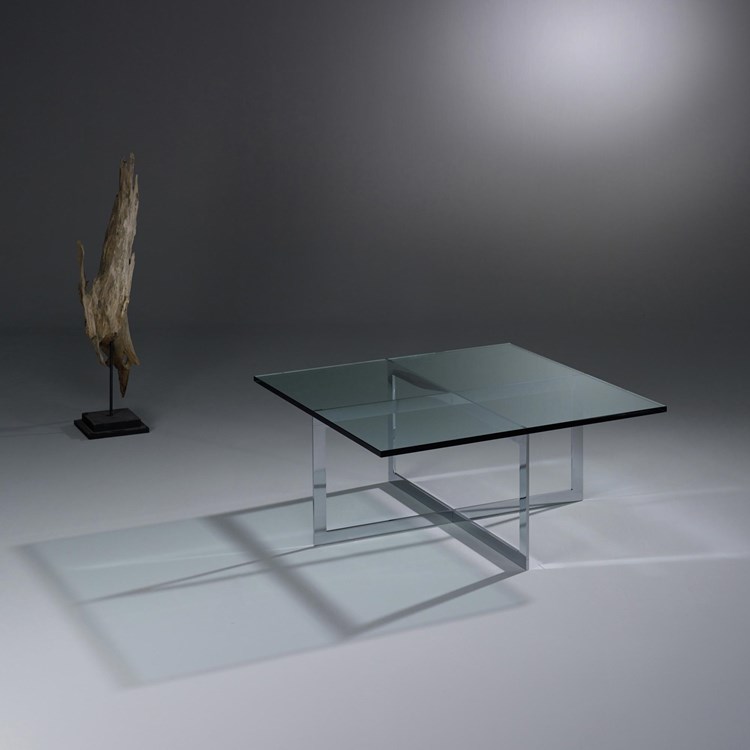-
Free Delivery in DE, AT & CH
-
Made in Germany
-
Individual Customisation Available
Author: DREIECK DESIGN Editorial Team
Last updated: 07/10/2025
Glass is more than just a transparent material—it's a statement. It creates openness, reflects light, and embodies timeless elegance. At the heart of modern glass design, you will almost always find float glass, a material of exceptional purity and perfection. But what exactly does this term mean? How is it made, and what makes it the first choice for high-end designer furniture?
In this comprehensive guide, we dive deep into the world of float glass. As a manufacturer that has been shaping glass into purist works of art for decades, we share our expertise and show you everything you need to know about this fascinating material.
The modern float glass process, developed in the 1950s by Alastair Pilkington, revolutionized glass production. It is a continuous process that runs around the clock and can be divided into four main stages:
Float glass is often further processed into tempered safety glass (ESG). While this thermal process increases its impact resistance, it also creates permanent internal stress that can be visible in its optics ("anisotropies"). Our philosophy is different: We preserve the pure, unaltered aesthetic of the original float glass. Instead of modifying the material, we achieve the necessary stability and safety through two key factors: a sufficiently high material thickness and a thoughtful, structurally intelligent design. This is our commitment to authentic, materially honest design.

(Intelligent design meets strong material: The MILES coffee table made of 15 mm thick float glass is a perfect example of stability through form.)
In our German manufactory, flat float glass is transformed into three-dimensional objects. One of our core competencies is high-precision UV bonding. In this technique, a special adhesive is applied to the edge of a glass pane and joined with a second pane. When exposed to UV light, the adhesive cures to be completely transparent, creating an incredibly strong bond—often stronger than the glass itself. This results in furniture that appears to be cast from a single piece, without any visible joints or mechanical fasteners. This process demands the utmost skill and years of experience.

(Masterful precision: On the FLY desk, the drawer unit is seamlessly bonded to the glass top—a demonstration of perfect craftsmanship.)
Designer furniture made of float glass is not only beautiful but also surprisingly easy to care for. With the right maintenance, it will remain brilliant for decades.
Float glass is naturally hard and scratch-resistant. Fine, superficial scratches can sometimes be polished out by a professional using a special glass polish. For deeper scratches, however, a repair is rarely invisible. The best protection is prevention: use coasters for hot pots and do not place sharp-edged objects on the glass surface.
Pure, high-quality float glass is more than just a material—it is the foundation for design that endures. Its brilliant clarity and the potential for precise shaping make it the first choice for furniture that is not only functional but also sculptural. It embodies a modern, light, yet durable aesthetic. Discover the timeless beauty of float glass in our collection and experience how this fascinating material can enrich your home.
Float glass is used in many different ways, e.g. B. for window panes, glass furniture, glass facades, mirrors, aquariums and much more.
How stable a pane of glass is is indicated by its "strength", e.g. B. their "flexural strength". The flexural strength of untreated float glass is around 45 N/mm², that of ESG float glass is at least 120 N/mm² and up to 200 N/mm². For comparison: The flexural strength of chipboard is approx. 12-25 N/mm².
Float glass refers to flat glass that was manufactured using the so-called float glass process. The molten glass floats on a tin bath, creating an even surface. It is then cooled down to the desired temperature and cut to size.
There is no "better," only a different aesthetic. Classic float glass has a very elegant and timeless look with its subtle green tint. Optiwhite glass is the right choice when a 100% color-neutral, ultra-transparent, and more modern appearance is desired. You can read more in our comprehensive Optiwhite guide.